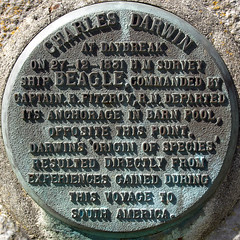Commemorated on 2 plaques
Charles Darwin 1809-1882 arrived at Falmouth aboard 'The Beagle' on 2nd October 1836 and departed on the Royal Mail coach from this site
Fish Strand Hill, Falmouth, United Kingdom where it landed near (1836)
Charles Darwin At daybreak on 27-12-1831 H M Survey Ship Beagle. commanded by Captain R. Fitzroy RN departed its anchorage in Barn Pool, opposite this point. Darwin’s ‘Origin of Species’ resulted directly from experiences gained during this voyage to South America.
, Plymouth, United Kingdom where it sailed from (1831)


